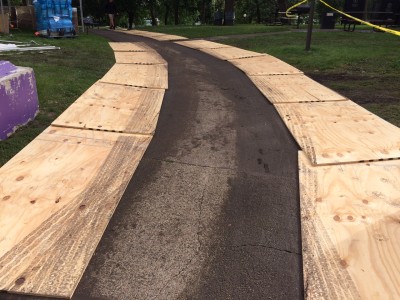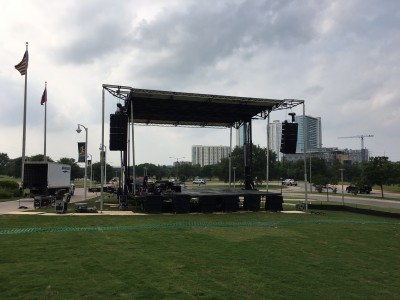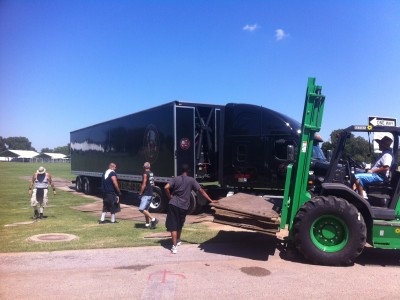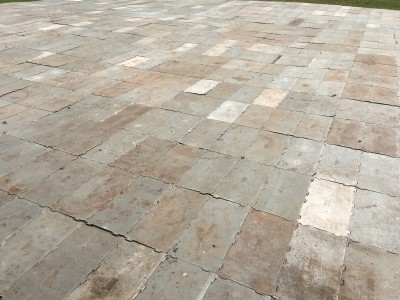-
Proper Plywood Protocol – How to Get the Most out of Your Festival Ground Protection
At virtually every outdoor festival or special event, you will be able to spot some plywood. And while it’s simple to use, there are ways to make sure you’re getting the most out of the easiest ways to have ground protection.
Below is a cross-section of plywood with a particleboard core (courtesy of Fine Lumber, click to view other examples) which gives you an idea of what on kind of plywood consists of – the face and back veneers are applied directly to either a core of particleboard or medium density fiberboard:
First, what situations would you need plywood on hand for? Anytime your event is on a field or unpaved surface and may have:- Heavy machinery – either to ensure they won’t get stuck in mud, destroy the existing lawn, or both
- Mobile stages – plywood helps ensure the truck dropping off the stage can get in and out properly, and placing plywood under the stage’s supports / outriggers can help distribute the load and not entirely kill the grass underneath.
- Subwoofers – often it makes sense to place plywood under large subs that get spread across the front of the stage, so they don’t get stuck and are easy to remove during load out.
- Food preparation – check with your local health / fire department regulations, but most food vendors are required to have flooring for their cooking areas. Sometimes plywood isn’t enough, but it can work in some cases.
- Pedestrian footpaths – especially for unpaved areas that are used to load-in / out artist gear, vendor gear, and the like, it’s imperative there is a flat, sturdy surface for road cases to roll on and for people to traverse without getting stuck.
So, you’ve established that you need some plywood. How much should you order and what size / type?- Plywood is normally sold by the bunk (or bundle, or lift), which is 48 sheets. Dimensions are most often 4′ x 8′, and they are often delivered on flatbed tractor trailers. Each bunk can weigh as much as 2000 lbs, which is why it’s essential to have a forklift capable of holding that much weight at once.
- To ensure that you get enough strength, you’ll want 3/4″ of thickness. If you know you aren’t going to be moving heavy machinery over it, 1/2″ may suffice.
Places like Fine Lumber in Austin sell many different types of plywood in bulk quantities, nationwide, there are often several local suppliers in every major market – just do a google search for “bulk plywood [your city here]”; for smaller orders, your local Home Depot or Lowe’s will have sheets available, sold individually from approximately $15 and up per sheet.
Next, you’ll want to assemble a site crew dedicated to plywood distribution. For smaller events, the crew could be part of your general site crew; for larger events, you’ll want a separate crew that does nothing but goes around site on demand and lays down (or picks up) plywood as needed.
Here’s a general set of instructions for the plywood team:- Arrive and be ready to work at the designated meet up spot / production office a minimum of 15 minutes before your call time, so you can be ready at the start of your call time. Make sure you’ve got a radio if one is allocated to you and that your battery is fresh.
- Receive the initial punch list of places that need plywood from your supervisor.
- Check out or make sure you know where your designated flatbed golf cart is. Make sure you have a cooler and waters/ice on hand for your team in the cart. Make sure you know for sure where your golf cart is allowed to drive; sometimes all vehicles may be banned from grassy areas due to rainfall.
- Get with your team and start working on loading up plywood on the flatbed. Larger events may also have a fork operator on a forklift to handle larger amounts of plywood distribution. Note that the fork will not likely be able to use the grass unless it has turf tires (and in some cases, not even then). You will have to build out plywood roads if you need the fork to reach somewhere in the field.
- Your crew will need to break for lunch no earlier than 5 hours into a shift. Meals are either a 30 min on-site break (with food being provided by the festival) or a 1 hour walk-away. Try to plan the breaks during anticipated downtime when possible.
- After your call is over, make sure to drive back the golf cart and check it out (if necessary), return your radio, and get any updated call time / punch list for the next day’s work from your supervisor.
When handling plywood, here are some tips:- Try to keep the various sources of it separate – sometimes there will be rented ply (usually painted green or another color on the side), regular ply, and ply designated to a specific department (like bar operations). You do not want to use other departments’ ply unless given the green light by their team. During load out, you will be asked to provide separate bunks of plywood by type.
- Remember that if it rains heavily, the plywood will get heavier, muddier, and less stable. Be sure to allow for extra time and extra breaks for your crew as the workload / effort essentially doubles.
- Make sure your crew knows how to lay down plywood in a way that works best for the task at hand; for example, if they are building a row that someone is using to roll road cases out, make sure the overlap on the plywood is such that it’s easiest for them to roll in that direction.
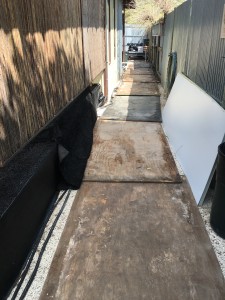
Notice how the plywood sheets overlap just a bit so it’s easier for road cases to move along the path
- Try to keep tabs of where you have plywood out – it will get used virtually across the entire site and you’ll need to know where/when you can pick it up and deploy it elsewhere or consolidate it.
- Ideally it’s best to have all plywood off the ground before leaving for the day but some exceptions can be made; check in with your supervisor and let them know what’s going on.
And finally, when plywood isn’t good enough, there are now several more durable options offered by a few companies:- EPS has aluminum rolls that can handle very head loads (for cranes, 10K forks, and so on) which your plywood crew can also lay out using a 5k fork. These are mostly for larger festival needs (steel stages, larger mobile stages, large tent builds).
- Terraplas features ground protection that come in small sections which can be built up to accommodate virtually any size need for ground protection. These are great for having proper flooring in catering, bar, food vendors, and other high traffic areas that often get wet but don’t need the extra support and durability for heavy machinery.
- There is also a new type of ground protection offered by companies like Sunbelt that falls in between the aluminum rolls and plywood in regard to strength and durability. It can be rented in 4′ x 8′ sections and offers a more rugged solution than standard plywood.
- Heavy machinery – either to ensure they won’t get stuck in mud, destroy the existing lawn, or both



